![]()
![]()
![]()
Use LEFT and RIGHT arrow keys to navigate between flashcards;
Use UP and DOWN arrow keys to flip the card;
H to show hint;
A reads text to speech;
87 Cards in this Set
- Front
- Back
|
The Skeletal System
|
.....
|
|
|
What are the functions of the skeletal system?
|
Support - provide a framework for attachment of soft connective tissues, such as muscles.
Protection - protect internal organs such as heart/lungs. Movement - when the muscles contract and pull on bones it produces movement. Mineral Storage - store calcium and phosphorus, which are released when needed. Blood Cell Production - most blood cell formation occurs within the red bone marrow. Storage of Energy - yellow bone marrow is a stored source of lipids in the bones. |
|
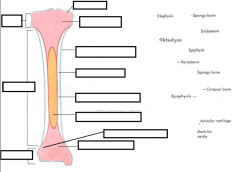
Label the components of the long bone (left section first and then the right)
|
Left:
Epiphysis, Diaphysis, Epiphysis Right: Articular Cartilage, Spongy Bone, Periosteum, Compact Bone, Medullary Cavity, Spongy Bone, Articular Cartilage |
|
|
List the other types of bones and their functions.
|
Short Bones - often cube shaped and can be found in the wrists, ankles, fingers and toes.
Flat Bones - appear flattened, found in the skull and breastbone. Irregular Bones - the bones that do not fit in other categories. Examples: vertebra, facial bones and shoulder blade. Sesamoid Bones - embedded in tendons where pressure develops, example: the patella. Sutural Bones - located between the joints of some cranial bones. |
|
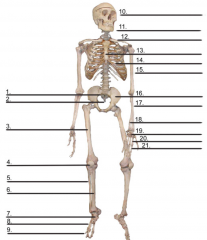
List the bones within the skeletal system from 1 to 26
|
1. Cranial Portion, 2. Facial Portion, 3. Clavicle, 4. Scapula, 5. Sternum, 6. Ribs, 7. Vertebral Column, 8. Humerus, 9. Ulna, 10. Sacrum, 11. Pelvic Hip Girdle, 12. Cocyx, 13. Sacrum, 14. Ulna, 15. Radius, 16. Carpals, 17. Metacarpals, 18. Phalanges, 19. Femur, 20. Patella, 21. Patella, 22. Tibia, 23. Fibula, 24. Tarsals, 25. Metatarsals, 26. Phalanges
|
|
|
Name the sections of the axial skeleton.
|
Cervical Vertebrae: C1 - C7 (7 vertebrae)
Thoracic Curvature: T1 - T12 (12 vertebrae) Lumbar Curvature: L1-L5 (5 vertebrae) Sacrum: 5 fused vertebrae Coccyx: 4 fused vertebrae |
|
|
What is a fibrous joint?
|
where the bones have no joint cavity, and they are held together by strong connective tissue.
|
|
|
What is a cartilaginous joint?
|
where the bones have no joint cavity, and they are held together by cartilage.
|
|
|
What is a synovial joint?
|
where the bones have a joint cavity, and they are held together by ligaments and separated by synovial fluid in the joint cavity.
|
|
|
List the function of structures found within the synovial joints
|
Articular Capsule - a capsule that encloses the joint cavity.
Articular Cartilage - a connective tissue covering the surface of articulating bones. Synovial Fluid - a secretion that lubricates and nourishes the articular cartilage. Bursa - a small sac containing synovial fluid, located at friction sites between bones and tendons. Tendons - fibrous cords of dense connective tissue that attaches muscle to bone. Ligaments - dense connective tissue that attaches bone to bone. |
|
|
List and describe the six different types of synovial joint.
|
Gliding Joint - side to side, or back and forth, the movement is permitted across flat surfaces. Example: between the carpals and tarsals.
Hinge Joint - the convex surface go one bone fits into the concave of another, movement occurs in one plane. Example: elbow and knee joint. Pivot Joint - primary movement is rotation, rounded/pointed surface of one bone articulates with the depression/opening of another. Example: proximal end of the radius and ulna. Ellipsoid - oval-shaped condyle of one bone fits into the elliptical depression of another and movement occurs in two planes. Example: metacarpals and phalanges. Saddle Joint - the articular surface of one bone is saddle shaped and the other bone sits on it like a rider. Example: between the carpal and metacarpal of the thumb. Ball and Socket - ball like surface of one bone fits into the depression of another and are very moveable. Examples: shoulder and hip joint. |
|
|
Name and functions of the 16 joint actions.
|
Flexion - decreasing the angle between two bones.
Extension - increasing the angle between two bones. Abduction - movement of bone away from the midline. Adduction - movement of bone towards the midline. Pronation - movement of forearm so palm is posterior or inferior. Supination - movement of forearm so palm is anterior or superior. Elevation - raising of body part. Depression - lowering of body part. Protraction - thrusting forward of a body part. Retraction - withdrawing of a body part. Dorsiflexion - bending of foot towards the shin. Plantarflexion - bending of foot away from shin. Inversion - rotation of sole of foot inwards. Eversion - rotation of sole of foot outwards. Rotation - movement of a bone around its longitudal axis. Hyperextension - excessive extension of a body part. |
|
|
The Muscular System
|
.....
|
|
|
Describe the three types of muscle tissue in the body.
|
Skeletal Muscle - primarily attached to bones and moves the skeleton. contraction is under our direct control and so the movement of the muscle is said to be voluntary.
Cardiac Muscle - forms most of the heart. Muscle is striated and because contractions occur without us knowing, muscle is said to be involuntary. Smooth Muscle - on the walls of internal structures, such as the stomach, blood vessels and intestines. It is non striated , movement is usually involuntary. |
|
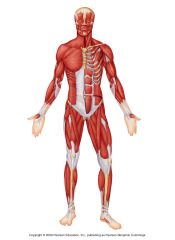
List the major muscles in the muscular system.
|
Anterior:
1. Trapezius, 2. Deltoid, 3. Pectoralis Major, 4. Biceps Brachi, 5. Triceps Brachi, 6. Latissimus Dorsi, 7. Rectus Abdominis, 8. External Oblique, 9. Quadriceps, 10. Tibials Anterior, 9. Gastrocnemius, Soleus. Posterior: Gluetus Maximus, Hamstring |
|
|
What are the three groups muscles can be classified as.
|
Agonists (prime movers) - provides the main force that causes the desired movement.
Antagonist (muscles that react) - the muscle that opposes or reverses a particular movement. Stabilisers (synergists and fixators) - muscle that aids agonists by promoting the same movement or reducing unnecessary movement or undesired action. |
|
|
what are the types of muscle contraction?
|
isotonic contraction and isometric contraction.
|
|
|
what happens during an isotonic contraction?
|
An isotonic contraction the muscle length changes (shortens and lengthens) as tension develops.
two possible types of isotonic contractions are: concentric isotonic contraction - the muscle shortens eccentric isotonic contraction - the muscle lengthens. |
|
|
What happens in an isometric contraction?
|
when the muscle length does not change, example: holding the iron cross
|
|
|
Respiratory System
|
.....
|
|
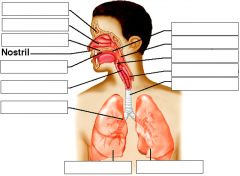
list the anatomy of the respiratory system
|
1. Pharynx, 2. Larynx, 3. Trachea, 4. Lung, 5. Primary Bronchus, 6. Bronchioles
|
|
|
Function of the lungs
|
bring oxygen into the body and remove carbon dioxide
|
|
|
Function of the bronchi
|
the main passageway into the lung.
|
|
|
Function of the Alveoli
|
the exchange of gases occurs here across a thin membrane.
|
|
|
what is inspiration and expiration?
|
Inspiration - the breathing in of air.
Expiration - the breathing out of air. |
|
|
Circulatory System
|
.....
|
|
|
What percent does blood account for in the total body weight.
|
8%
|
|
|
What is plasma? and what is the percent it makes up in the volume of blood.
|
The liquid portion of blood that is straw-coloured and makes up 55 per cent of the volume of blood (91.5% of blood plasma is water; the other 8.5% is made of nutrients, waste, proteins, enzymes and hormones).
|
|
|
What percent of blood do the red blood cells contribute to the human body?
|
45%
|
|
|
What are erythrocytes?
|
red blood cells.
|
|
|
what are white blood cells called?
|
leucocytes.
|
|
|
What is the haemoglobin?
|
an oxygen-carrying pigment found in the erythrocyte and are formed in the red bone marrow.
|
|
|
What is the function of leucocytes?
|
they exist to combat infection and inflammation
|
|
|
What are the two chambers of the heart?
|
the atrium and the ventricle.
|
|
|
What are the superior chambers of the heart?
|
the left atrium and the right atrium
|
|
|
What are the inferior chambers of the heart?
|
the left ventricle and the right ventricle.
|
|
|
What is the function of the heart?
|
they are receiving chambers of blood that is returning to the heart
|
|
|
What do valves do?
|
prevent the back flow of blood into chambers by opening/shutting when the heart contracts and relaxes.
|
|
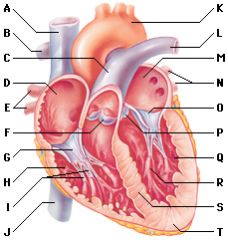
List the structures of the heart (a-t)
|
A. Superior Vena Cava, B. right pulmonary artery, C. pulmonary trunk, D. Right Atrium, E. Right Pulmonary Veins, F. Pulmonary Semi Lunar Valve, G. Tricuspid Valve, H. Right Ventricle, I. Chordae Tendinee, J. Inferior Vena Cava, K. Aorta, L. Left Pulmonary Artery, M. Left Atrium, N. Left Pulmonary Veins, O. Mitral Valve, P. Aortic Semi Lunar Valve, Q. Left Ventricle, R. Papillary Muscle, S. Interventricular Septum, T. Myocardium
|
|
|
list the three types of of blood vessels.
|
Arteries, veins and capillaries.
|
|
|
What is the function of the artery?
|
Arteries carry blood away from the heart to tissues while blood is being pumped through them at high surges (pulse).
|
|
|
What is the function of the vein?
|
the vein carries blood from tissues back to the heart.
|
|
|
What is the function of capillaries?
|
they are small networks of vessels where nutrients are exchanged between blood and cells of the body. Lie between arterioles and venules, connecting both systems.
|
|
|
What is the difference between pulmonary and systematic circulation?
|
Pulmonary circulation circulates blood from the right side of the heart to the lungs, then back to the heart.
Systematic Circulation pumps blood from the left side to body tissues, then back to the right side of the heart. |
|
|
What is the difference between deoxygenated and oxygenated blood?
|
deoxygenated blood occurs with little oxygen, enters through the vena cava and flows into the right ventricle, which pumps into the lungs via left and right pulmonary arteries.
oxygenated blood occurs with oxygen, enters the left atrium via four pulmonary veins, then flows into the left ventricle. |
|
|
What is systolic blood pressure?
|
is the peak pressure in the arteries, which occurs near the end of the cardiac cycle when the ventricles are contracting.
|
|
|
what is diastolic blood pressure?
|
is the minimum pressure in the arteries, which usually occurs near the beginning of the cardiac cycle when the ventricles are filled with blood.
|
|
|
What is blood pressure usually measured with?
|
usually measured with a stethoscope and sphygmomanometer.
|
|
|
Components of Fitness
|
.....
|
|
|
How many components of fitness are there?
|
11 - 5 health related and 6 skill related
|
|
|
list the health related components of fitness
|
cardiorespiratory endurance, muscular strength, muscular endurance, flexibility, body composition
|
|
|
list the skill related components of fitness
|
power, speed, agility, coordination, balance, reaction time.
|
|
|
list suitable tests for cardiorespiratory endurance
|
- multi stage fitness test
- cycle ergo meter test - 12 minute run - 2.4 km or 1.6 km run - step tests |
|
|
list suitable tests for muscular strength
|
- dynamometers (back, leg and hand)
- one rep. maximum tests |
|
|
list suitable tests for muscular endurance
|
- sit up test
- push up test - pull up test - flexed arm hang test |
|
|
list suitable tests for flexibility
|
- goniometers
- sit and reach test - shoulder rotation test - ankle extension test |
|
|
list suitable tests for body composition
|
- body mass index
- skin fold tests - waist to hip ratio - girth measurements |
|
|
list suitable tests for power
|
- standing long jump
- vertical jump |
|
|
list suitable tests for speed
|
- sprint tests over 20-60 meters.
|
|
|
list suitable tests for agility
|
- burpee test
- figure 8 agility run - shuttle run |
|
|
list suitable tests for coordination
|
- alternative ball toss
- hand wall toss - catch |
|
|
list suitable tests for balance
|
- one foot balances
- stork stand - static and dynamic balance boards |
|
|
list suitable tests for reaction time
|
- ruler reaction time test
- computer reaction time test |
|
|
Aerobic and Anaerobic Training
|
.....
|
|
|
what is aerobic training? examples
|
training that uses oxygen to break down/metabolise energy sources to create movement. performed at low to moderate intensity at a steady pace that can continue for a long period of time.
examples: walking, jogging, swimming, dancing, cycling. |
|
|
what is anaerobic training? examples
|
training that involves a workload that is intense and short in duration. relies on stored energy in the body that can be metabolised in the absence of oxygen.
examples: sprinting, long jump, shot put, sprints in football, weightlifting, lay up in basketball, push off wall in swimming. |
|
|
FITT Principle
|
.....
|
|
|
What does FITT principle stand for?
|
F - frequency
I - intensity T - time T - type |
|
|
how to measure maximum heart rate
|
220-age
60% x age = minimum heart rate 85% x age = maximum heart rate |
|
|
Immediate and Physiological responses to training
|
.....
|
|
|
what are the 6 immediate physiological responses to changes?
|
heart rate (HR) - rate at which the heart beats
ventillation rate - the increase in ventilation when exercise begins stroke volume (sv) - amount of blood ejected with each contraction, heart also increases. cardiac output (Q) - volume of blood pumped out of the heart per minute, increases in exercise, forcing more blood out of the heart. lactate levels - levels rise when aerobic exercise is occurring and evens out with lactate being removed as fast as it is made. |
|
|
formula for calculating cardiac output?
|
Q=HR x SV
|
|
|
Measuring the Components of Physical Fitness
|
.....
|
|
|
What are the 6 linear kinematics?
|
distance, displacement, speed, velocity, acceleration and momentum.
|
|
|
how to measure distance?
|
measured in meters and kilometers
|
|
|
how to measure displacement?
|
measured by the length from the starting and ending points (meters or kilometres with compass direction).
|
|
|
how to measure speed?
|
distance divided by time taken
|
|
|
how to measure velocity
|
displacement of velocity divided by the time taken
|
|
|
how to measure acceleration?
|
change in velocity divided by time = final velocity
|
|
|
how to measure momentum?
|
mass x velocity (kg m/sec)
|
|
|
Acceleration
|
.....
|
|
|
Define acceleration with examples
|
the ability to increase velocity rapidly.
examples: softballer stealing a base needs to increase velocity, then needs to slow down to not run past the base (deceleration). |
|
|
Momentum
|
.....
|
|
|
define momentum with examples
|
the quantity of motion the body possesses. once in motion it tends to stay in motion unless acted on by another force.
example: increasing velocity on a bat, the cricketer can hit a ball further. |
|
|
How the Body Absorbs Force
|
.....
|
|
|
what are propulsive and resistive forces?
|
propulsive - external force that acts to cause motion in a body.
resistive - force that acts to resist the movement created by propulsive force |
|
|
list some of the precautions when colliding
|
- use large surface when landing/catching
- keeping a distance between impacting objects - as much mass when landing/catching - regulating position of centre of gravity - using materials other than body parts - 'give' with the impact |

